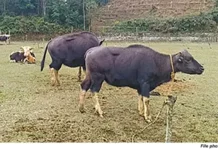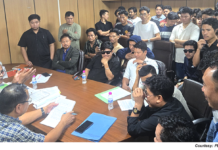[ Nani Bath ]
“If you meet a girl, you meet a girl. It’s normal; so if you exchange numbers, whatevs, it’s cool,” says Zayn Malik. So, numbers do matter for the youngsters, and numbers are no less significant for the policymakers. The World Bank would say, “They are the evidence on which policies are built. They help identify needs, set goals, and monitor progress.”
The emotionally-driven issue of Chakma-Hajong, more often than not, gets hidden in the number game. The All Arunachal Pradesh Students’ Union (AAPSU), which spearheads the movement against ‘outsiders’, quotes different figures on different occasions – from sixty thousand to one hundred thousand. ‘Why Arunachalees are opposed to permanent settlement of Chakma and Hajong refugees in Arunachal Pradesh?’, an undated pamphlet issued by the AAPSU, has mentioned a figure of “over 60,000.”
The chief minister’s statement on the floor of the legislative assembly has been quoted differently by different news agencies and local dailies. The chief minister stated that the total population of Chakmas and Hajongs was “65,875 approximately, as per the special survey 2015-16.”
The state government’s ‘White paper on Chakma and Hajong refugee issue’ (1986) remains the most quoted document on the status of the Chakmas and the Hajongs. The white paper mentions that “Between 1964-69, about 2,748 families of Chakmas and Hajongs comprising of 14,888 persons approximately went to the then NEFA.”
The district-wise figures are: Lohit (1,192 Chakmas); Subansiri (1,133 Chakmas); Tirap (Chakmas – 11, 813 and Hajongs – 750).
An exclusive survey on the Chakmas and the Hajongs was carried by the government in 1979. The population increased to 21, 494 from 14,888 in 1969: Lohit (1900 Chakmas); Subansiri (1,600 Chakmas); Tirap (Chakmas – 16,853 and Hajongs – 1,141).
The Chakmas are presently spread over three districts of Arunachal Pradesh: Papum Pare, Namsai and Changlang. In Papum Pare, they were settled originally in 10 settlement areas, officially referred to as blocks. Presently they are concentrated in eight blocks in between the Maguni river (Hollongi) and the Chessa river (Kokila), measuring approximately 12 to 14 kms. As per the ‘Survey report of Chakma’ (2010-11) by the Papum Pare district administration, there are 2,077 Chakmas in the district. The 2011 census reports the total Chakma population to be 2,065.
There are three villages (Chakma-I, Chakma-II and Chakma-III) in Gunanagar, near Chowkham in present-day Namsai district, with a total population of 4962 persons. Chakma-I settlement area has a total population of 2404; 1264 in Chakma-II and 1294 in Chakma-III, as per the survey report (2010-11) of the deputy commissioner, Namsai. According to the 2011 census report, it has a total population of 4, 523.
The maximum number of Chakmas (around 90 percent) and the whole of the Hajong population are spread over three circles of Changlang district.
The ‘Special survey on Chakma-Hajong population’ (2010-11) is a report of an extensive survey done on the Chakmas and the Hajongs by the office of the deputy commissioner, Changlang. The survey was conducted using two formats: Format-I, which lists out the total population that had originally been settled between 1964 and ’69. In Format-II, the total population who were settled after 1969 (mostly illegal settlers) are enlisted. According to this report, the total population of the district is 44,276 persons. Those who settled in between 1964 and 1969 are 27,184 in number, and the Chakmas who have settled after 1969 have a total population of 17,092 persons.
Miao circle has 15 settlement areas, including M’Pen, Miao Bazar and Deban. It has a total population of 10,856. With three settlement areas (Ratnapur, Milonpur and Golakpur), Kharsang circle’s total population is 1,439. Bordumsa circle has an equal number of settlement areas (Bijoypur-I, Bijoypur-II and Bijoypur-III) with a total population of 5, 538.
Diyun administrative circle has the maximum concentration of Chakmas and Hajongs, having 26, 443 Chakmas and 2, 415 Hajongs. There are 17 Chakma and four Hajong settlement areas. The Hajongs are settled in Haripur (878), Modhupur-I (533), Madhupur-II (480) and Srirampur (524) areas of Diyun circle.
As per the 2011 census, Miao circle has a population of 10, 322 persons. Bordumsa and Diyun have 5,262 and 25,078 persons, respectively. The Hajong population in Diyun circle stands at 2,365.
The Asian Centre for Human Rights, quoting the 2011 census, has reported the total population of Chakmas and Hajongs in Arunachal Pradesh as 47,471 persons. However, my research team found it difficult to establish the total population of the Chakmas in Changlang district as per the 2011 decadal census. This is because the Chakma population could not be segregated since Milonpur, Ratnapur and Golakpur under Khagam CD block of Miao circle are not provided separate census identity. Besides, Diyun headquarters, a census village, comprises mixed population.
Hence, it would be wrong to maintain that no comprehensive survey to ascertain the actual number of Chakma-Hajong refugees in the state has been conducted. The survey conducted during 2010-2011 by the respective district administrations comprehensively recorded the actual numbers of Chakmas and Hajongs, with photographic evidence in some instances.
What is important is the need for an updated survey, keeping in view the apprehensions and concerns of the host communities. Reports have suggested that there are different categories of Chakmas. The first group (core group) of Chakmas is those who were settled during 1964-69. The second group consists of Chakmas who have shifted from one refugee camp to another within the state. Those who have come or are coming from Assam, Tripura or Mizoram constitute the third group. The fourth group consists of those who have migrated or are illegally migrating from Bangladesh.
What is equally important is the need for a comprehensive survey on the numbers of Ahoms, Sonowal Kacharis, Morans, Adivasis, Deoris, Misings, Karbis, ex-serviceman belonging to the Gorkha communities, and Tibetans. They are the de facto occupants of land within the state’s territory but without legal authorization.
The numbers are there, but what is lacking is a political will to tackle the more than half-a-century-old issue. The issue got highlighted when a statement was issued by the home ministry, indicating that “the Centre decided to grant ‘limited citizenship’ to the Chakmas and Hajongs.” Mahendra Chakma of the Right Cause Society, Bangalore, called it a “masterstroke by the government.” He adds, “It has satisfied the innocent Chakma and Hajong people by claiming it is giving them citizenship. …it has assuaged those with anti-refugee sentiments by saying that the Chakmas would require inner line permits.”
The AAPSU and other indigenous organisations have called for “sharing of burdens,” which means that the Chakmas and the Hajongs must be settled elsewhere in India after citizenship is granted. My understanding is that a democratic solution has to be found out somewhere in between these extreme views. For the final solution, all stakeholders have to imagine and act beyond the numbers, so that the issue comes out quickly from the political quagmire.
To sum up, let’s not be confused over the numbers. As someone said, “Women lie, men lie, but numbers don’t lie.” The prime minister’s magic number of ‘Rs 15 lakhs to every Indian’ is still fresh in the minds of the Indian voters. (The author may be contacted at nanibath@rediffmail.com)


